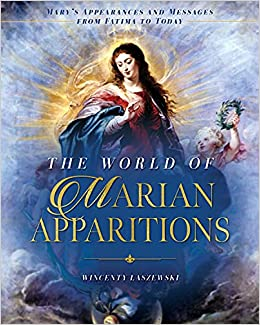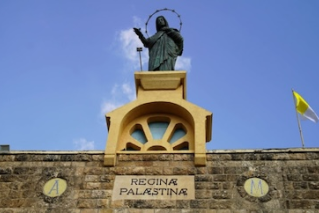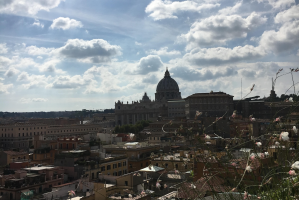Book: The World of Marian Apparitions

7/10 The World of Marian Apparitions by Wincenty Laszewski published by Sophia Institute Press
My Catholic primary school taught us stories from the Bible, one between two at a shared desk. We also heard about miracles outside Scripture, including visitations of Our Lady, especially at Lourdes and Fatima. I came to feel the emphasis on these 'private revelations' was excessive, but visiting England's Walsingham, a shrine for almost 1000 years, set me thinking about the role of Mary ever since.
We'd been told that only Catholics honour Mary, yet Walsingham has beautiful Anglican and Orthodox Shrines as well as the Catholic one. Each one made us welcome. We learned that icons like the Mother of Perpetual Succour came from the East. Later, joining ecumenical pilgrimages meant walking and talking, eating and praying together.
This book may inspire the reader to go on pilgrimage to one of the featured shrines, or to turn the pages while voyaging in imagination, beads in your hand, a candle and pilgrim's shell beside you.The many well-chosen pictures will help you to be there.
Doctor Samuel Johnson, a devout 18th Century Anglican philosopher, had this to say regarding pilgrimage: 'To abstract the mind from all local emotion would be impossible, if it were endeavoured, and would be foolish if it were possible'. In other words, there is room to be led by feelings as well as by intellectual theology when visiting shrines.
The book may set you thinking about Mary and her place in the life of the Church. When it first opened Walsingham's Anglican shrine attracted charges of 'Mariolatry' - idolising Mary. Less stridently, others judge the honour given to Mary to be obscuring her Son. But on the Feast of the Assumption this year, Pope Francis pointed out that Mary was and remains humble, so that God was able to beget his Son through her and pour out blessings through her, down to today. So it is in humility that we should set out on pilgrimage, on foot, by transport, or through the imagination.
Whoever receives an apparition can expect grief from a naturally sceptical world and a deliberately sceptical Church which has to discern the spirits at work in these incidents. But once the Church has accepted an apparition as genuine, we can follow Johnson's advice: 'Far from me, and from my friends, be such frigid philosophy as may conduct us indifferent and unmoved over any ground which has been dignified by wisdom, bravery, or virtue.'
Wincenty Laszewski has limited his explorations to apparitions beginning from the late 19th Century, thus omitting Lourdes which still witnesses renewal of faith as well as physical and emotional healings. Renewal and healing occur at other shrines too, and Laszewski leads us to many across the world.
Fatima, whose Sister Lucia certainly suffered at the hands of the Church, is well known but most of these shrines were new to me. At Beauraing, Belgium, in the 1930s the children who saw and heard Mary came from families indifferent to religion; it was only after the Occupation ended that the local bishop could pronounce the supernatural nature of the events. The children faded into the background, later marrying and raising Christian families. Thus they lived out their response to Mary's two questions: "Do you love my Son?" and "Do you love me?"
Far from there, in Ngome, South Africa, a German Benedictine missionary received visions in the 1950s. Sister Reinolda heard from Mary that she should be addressed as 'Tabernacle of the Most High', as she had held Jesus, the Host, in her womb and in her arms. It was time for Christians to be 'a sea of hosts' to bring Christ's salvation to the world; a poetic but doctrinally orthodox idea. We are the Body of Christ, as Saint Paul proclaims (1 Corinthians 12:27). Mary also asked for a shrine where seven springs come together.
In Egypt it was at a Coptic Orthodox Church dedicated to Mary that she was seen by thousands of Muslims and Christians on a number of occasions. As always there is scepticism from more than one side, theories of mass suggestion or natural phenomena or fakery, as Laszewski makes plain. But in the spirit of ecumenism which characterises Egyptian Christianity, the Catholic Church accepts the judgement of the Orthodox Patriarch's Commission that the apparitions, and subsequent individual healings, were God's work.
Scepticism is an honest position to adopt towards apparitions, and always the first stance of the Church which proclaims Christ Crucified, foolishness to the Gentiles (1 Corinthians 1:23). But Mary makes the sign of the cross during many apparitions, indicating that the Cross is central to her message. Those who accept the divine origin of the apparitions should not disdain people who are indifferent or unmoved.
As time goes by, shrines may continue to flourish in ways that the original visionaries could not have expected. Who would have predicted today's ecumenical scene in Walsingham? Mary was seen here before the Reformation, before even the Great Schism between Eastern and Western Christianity; now it is a place where some of those wounds are being healed. What blessings will be made available to the faithful and the world as these modern shrines find their lasting mission?
A few points regarding Wincenty Laszewski's labour of love. At p197 he wrongly portrays Frank Duff as seeking permission of St John Paul II to found the Legion of Mary. Duff had begun this work in 1921 in Dublin, more than half a century before meeting the Pope in Poland. Saint Pius X became Pope in 1903, not 1913. Laszewski relates how his predecessor, Leo XIII had a vision of the 20th Century and its evils. The Pope did not reveal details of this event, but Laszewski claims it as a Marian Apparition because Leo championed the Rosary. Pious suppositions are not history!
I would not be alone in scratching my head over Laszewski's description of Ngome as a place where natural realities came into contact with the supernatural. Springs of water have always been places where contact with the supernatural is a given, as at the Pool of Bethesda, or Lourdes, or many a holy well. In the words Chesterton put into the mouth of Mary, speaking to King Alfred:
The gates of Heaven are lightly locked, We do not guard our gain,
The heaviest hind may easily
Come silently and suddenly
Upon me in a lane.
Lord, grant us eyes to see with and discern your presence in the people we meet.


















